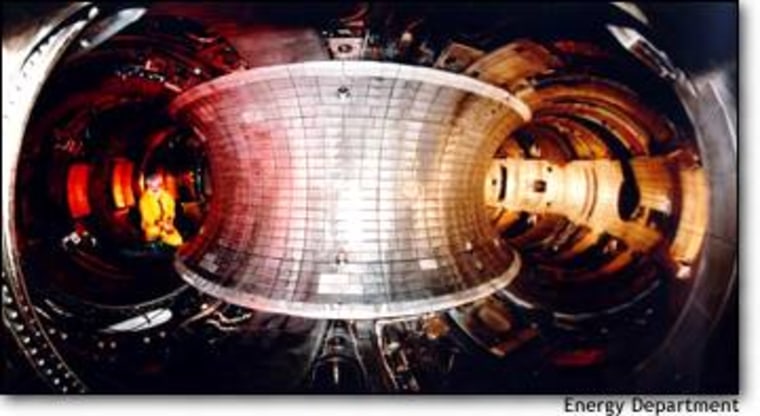What if you could build your own star and use its energy to power entire cities — all with much less environmental risk than traditional nuclear power? It might sound crazy, but scientists convened at the Bush administration’s request have drafted a report that concludes it’s feasible within the next 35 years to create, contain and then commercialize what’s known as fusion energy.
“STRENGTHENED SCIENTIFIC understanding of fusion systems, bolstered by the application of advanced computing, provides enhanced confidence that practical fusion systems can be realized,” the scientists wrote in their Nov. 25 report to the Department of Energy.
The energy source of the stars, fusion has actually been studied for 50 years as a potential source of energy that emits no air pollutants or gases tied to global warming. It does produce some short-lived radioactivity, but nothing like traditional nuclear power.
Unlike fission — which powers today’s nuclear power plants by splitting atoms, creating significant radioactive waste — fusion fuses hydrogen atoms and creates energy as a byproduct.
On top of that, its basic fuels — deuterium (a heavy form of hydrogen) and lithium — are abundantly available. Fifty cups of sea water, for example, contain enough deuterium to produce the same amount of energy as two tons of coal. Lithium, for its part, is a common element that would be used to extract tritium, a yet heavier hydrogen isotope that would fuse with the deuterium.
But the potential is matched by the formidable challenge involved: The fuels must be heated to 100 million degrees Celsius, at which point they become plasma. Then that temperature must be sustained and controlled so the resulting energy can be turned into electricity.
The panel acknowledged those hurdles as well as the fact that no single, best approach has been identified and that as a result investment should go to various projects. “It should be recognized,” they wrote, “that significant scientific and technological challenges remain for the development of fusion as a practical energy source, necessitating the use of a portfolio approach.”
‘ENTIRELY APPROPRIATE’
The report was requested last September by the Energy Department, which asked the 14 members of its Fusion Energy Sciences Advisory Committee to weigh in on the feasibility of commercial fusion power within 35 years.
In a first response ahead of their Nov. 25 meeting in Washington, the committee chair said the target was completely sound.
“Accomplishments of the program during the past few decades have been truly remarkable,” wrote Richard Hazeltine, director of the Institute for Fusion Studies at the University of Texas at Austin. “They have brought us to a point that makes the forward look described in your charge, including its explicit time scale, entirely appropriate.”
Those advances include scientists’ ability to better handle fusion. Thirty years ago, researchers reached a milestone by producing one-tenth of one watt of fusion power for one-hundredth of a second. Today they’re able to produce 10 million watts for about a second.
Anne Davies, a senior Energy Department official for fusion energy, agreed with Hazeltine’s view, adding that the biggest obstacles are financial, not technical. The fusion research program, she added, is “financially stressed,” receiving about $250 million a year now.

CHENEY TASK FORCE
When the Energy Department asked experts to weigh in, it was acting on a directive from the national energy task force, chaired last year by Vice President Dick Cheney.
In the task force’s report, fusion energy was described in glowing terms as not suffering from fission’s downside.
“There are no emissions from fusion, and the radioactive wastes from fusion are short lived, only requiring burial and oversight for about 100 years,” the report stated. “In addition, there is no risk of a melt-down accident because only a small amount of fuel is present in the system at any time. Finally, there is little risk of nuclear proliferation because special nuclear materials, such as uranium and plutonium, are not required for fusion energy.”
The report envisioned fusion power plants that not only deliver electricity to the power grid but also “power an energy supply chain based on hydrogen and fuel cells” — technology that could replace the internal combustion engines in vehicles with zero or near-zero pollution.
The advisory committee was asked to report back to the administration by Dec. 1 with its general advice and note any significant issues. A second report in March will lay out funding priorities.
Fusion researchers have long lobbied for an international experimental reactor, but the estimated $10 billion cost has unnerved many governments, including the United States, which backed out in 1998.
The administration asked the committee to take another look at a scaled-back international effort.
“The administration is trying to assure itself it’s the right thing to do,” Davies said.
The committee’s initial report, as well as background from the Office of Fusion Energy Sciences, are online at www.ofes.fusion.doe.gov/News.html.